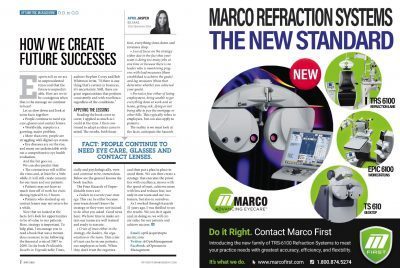
By April Jasper, OD, FAAO
Chief Optometric Editor
OptometricManagement.com
Original Article Published in Optometric Management, May 2020
–
Experts tell us we are in unprecedented times and that the future is unpredictable. How are we to be courageous when that is the message we continue to hear? Let us slow down and look at some facts together:
- People continue to need eye care, glasses and contact lenses.
- Worldwide, myopia is a growing, major problem.
- More than ever, people are struggling with digital eye strain.
- Eye diseases are on the rise, and many are undetectable without a comprehensive eye health evaluation.
And the list goes on. . .
We can also predict that:
- The coronavirus will still be the virus and, at least for a little while, it will still create concern for our team and our patients.
- Patients may not have as much time off of work for visits during typical 9-to-5 hours.
- Patients who stocked up on contact lenses may not return for a while.
Now that we looked at the facts, let’s look for opportunities to be of value to our patients. Here, strategy is important. To help plan, I encourage you to read a book that was a tremendous resource to me following the financial crisis of 2007 to 2008. In the book Predictable Results in Unpredictable Times, authors Stephen Covey and Bob Whitman write, “If there is one thing that’s certain in business, it’s uncertainty. Still, there are great organizations that perform consistently and with excellence, regardless of the conditions.”
APPLYING THE LESSONS
Reading the book cover to cover, I applied as much as I could at the time. I then continued to adapt as ideas came to mind. The results, both financially and psychologically, were and continue to be, tremendous. Below are the general lessons the book teaches:
The Four Hazards of Unpredictable times are:
- Failure to execute your strategy. This can be either because your team doesn’t know the strategy or they were not trained to do what you asked. Good news here: We have time to make certain our teams are well trained and ready to execute.
- Crisis of trust either in the strategy, the leaders, the organization or the team. This crisis of trust can be in our patients, our employees or both. When they don’t trust the organization, everything slows down and revenues drop.
- Loss of focus on the strategy either due to the fact that your team is doing too many jobs at one time or because there is no leader who is monitoring progress with lead measures (those established to achieve the goals) and lag measures (those that determine whether you achieved your goals).
- Pervasive fear either of losing employment, being unable to get everything done at work and at home, getting sick, dying or not being able to pay the mortgage or other bills. This typically refers to employees, but can also apply to patients.
The reality is we must look at the facts, anticipate the hazards and then put a plan in place to avoid them. We can then create a strategy that executes the priorities with excellence, moves with the speed of trust, achieves more with less and reduces fear, not only in our team and our customers, but also in ourselves. As I worked through hazards 11 years ago, I was thrilled to see the results. We can do it again and, in doing so, we will create value for our patients and achieve success.
Email: april.jasper@pentavisionmedia.com
Twitter: @OptoManagement
Facebook: @OptometricManagement

